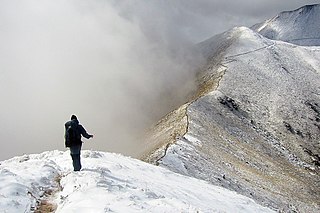This page is based on this
Wikipedia article Text is available under the
CC BY-SA 4.0 license; additional terms may apply.
Images, videos and audio are available under their respective licenses.

Te Wāhipounamu is a World Heritage Site in the south west corner of the South Island of New Zealand.

Kahurangi National Park in the northwest of the South Island of New Zealand is the second largest of the thirteen national parks of New Zealand. It was gazetted in 1996 and covers 4,529 square kilometres (1,749 sq mi), ranging to near Golden Bay in the north. Much of what was the North-west Nelson Forest Park formed the basis of the new park. Kahurangi Point, regarded as the boundary between the West Coast and Tasman Regions, is located in the park, as are the Heaphy Track and Mount Owen.

Te Anau is a town in the Southland region of the South Island of New Zealand. It is on the eastern shore of Lake Te Anau in Fiordland. Lake Te Anau is the largest lake in the South Island and within New Zealand second only to Lake Taupo. The 2013 census recorded the town's population as 1,911. The town has a wide range of accommodation, with over 4,000 beds available in summer.

Southland District is a territorial authority in the South Island of New Zealand.

Mount Tasman is New Zealand's second highest mountain, rising to a height of 3,497 metres (11,473 ft). It is located in the Southern Alps of the South Island, four kilometres to the north of its larger neighbour, Aoraki / Mount Cook. Unlike Aoraki / Mount Cook, Mount Tasman sits on the South Island's Main Divide, on the border between Aoraki/Mount Cook National Park and Westland Tai Poutini National Park. It is the highest point in Westland District.
Awarua Point is located on the southwestern coast of New Zealand's South Island, at the northern end of Big Bay, 40 kilometres (25 mi) north of Milford Sound, and 15 kilometres (9.3 mi) north of the mouth of the Hollyford River.

New Zealand has over three dozen marine reserves spread around the North, the South Island, and neighbouring islands, and on outlying island groups. They are governed by the Marine Reserves Act 1971 and administered by the Department of Conservation with assistance from the Ministry of Fisheries, New Zealand Customs and the New Zealand Defence Forces.

The Kepler Track is a 60 km (37 mi) circular tramping track which travels through the landscape of the South Island of New Zealand and is situated near the town of Te Anau. The track passes through many landscapes of the Fiordland National Park such as rocky mountain ridges, tall mossy forests, lake shores, deep gorges, rare wetlands and rivers. Like the mountains it traverses, the track is named after Johannes Kepler. The track is one of the New Zealand Great Walks and is administered by New Zealand Department of Conservation (DOC).
The Clinton River is a river in the Southland Region of the South Island of New Zealand. There is also a Clinton River in Canterbury, which is a tributary of the Puhi Puhi River.
The Gray River is a river in the Fiordland area of New Zealand. It arises in the Cameron Mountains in Fiordland National Park and flows south-west and then north-west into Revolver Bay, on the south side of Preservation Inlet.

The 2009 Fiordland earthquake struck the South Island of New Zealand with a magnitude of 7.8 at 9:22 pm (NZST) on 15 July. The earthquake was centred in the remote region of Fiordland, with the epicentre located 150 km (93 mi) west-north-west of Invercargill near Dusky Sound in Fiordland National Park, at a depth of 12 km (7.5 mi). It is among the largest New Zealand earthquakes to occur, including the Culverden/Kaikoura earthquake in 2016 and the 1931 Hawke's Bay earthquake, which both had a magnitude of 7.8.
Lake Paradise may refer to:

State Highway 95 is a New Zealand state highway connecting the town of Manapouri with Te Anau at State Highway 94. The highway is a major tourist road and skirts the eastern border of Fiordland National Park between Lake Te Anau and Lake Manapouri. Despite affording views of the scenic mountain ranges of Fiordland, the road itself is largely flat and passes through agricultural land. The entire length of the road lies on the Southern Scenic Route between Queenstown and Dunedin via Invercargill.
State Highway 97 (SH 97) is a New Zealand State Highway connecting the settlements of Five Rivers and Mossburn in the Southland region. The highway was gazetted in 2004 to reflect the increasing amount of traffic between the tourist destinations of Queenstown and Fiordland National Park and provides a bypass of the town of Lumsden, where SH 6 and 94 intersect.

Southland is New Zealand's southernmost region. It consists mainly of the southwestern portion of the South Island and Stewart Island / Rakiura. It includes Southland District, Gore District and the city of Invercargill. The region covers over 3.1 million hectares and spans over 3,400 km of coast.

The 2003 Fiordland earthquake struck the remote region of Fiordland in the South Island of New Zealand on 22 August 2003 at 0.12 am. The epicentre was 12 km deep, and was thought to be near Secretary Island at the entrance to Doubtful Sound. This was the same location as an earthquake of 6.7 Ms magnitude in 10 August 1993.














